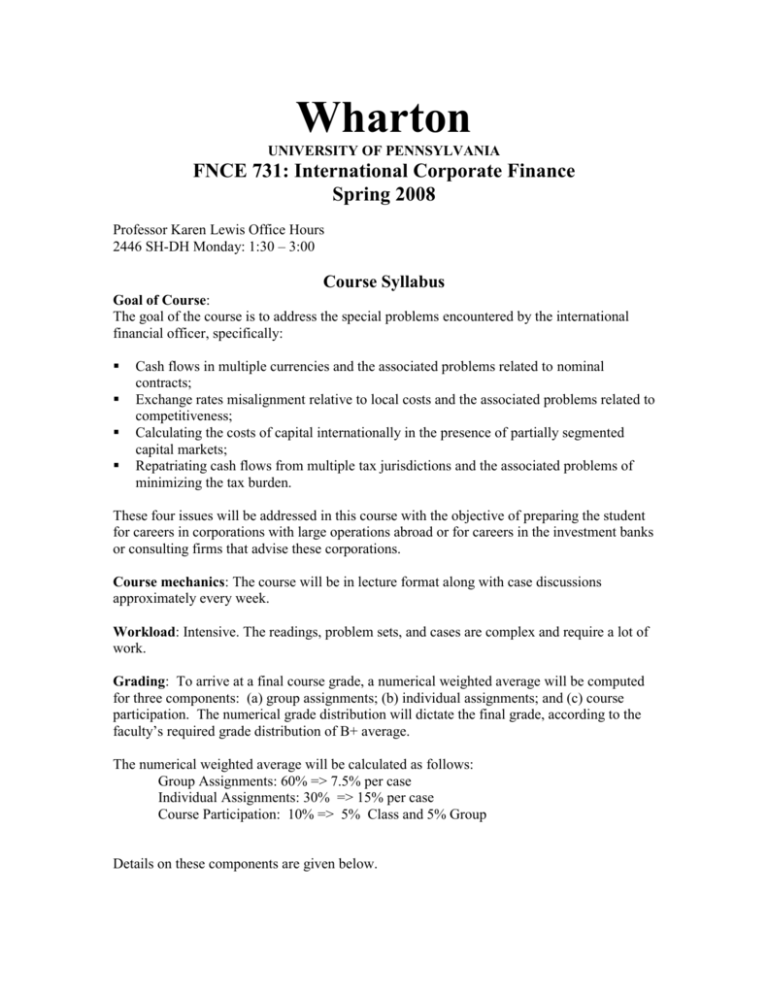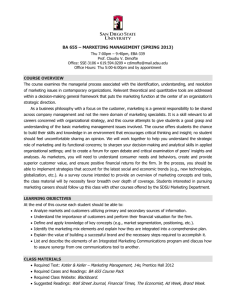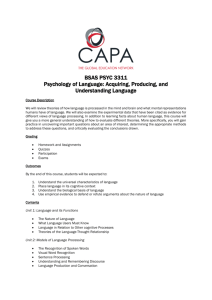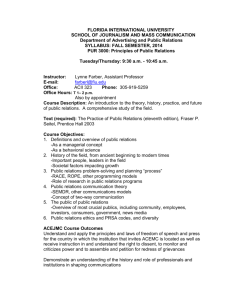Wharton - University of Pennsylvania
advertisement

Wharton UNIVERSITY OF PENNSYLVANIA FNCE 731: International Corporate Finance Spring 2008 Professor Karen Lewis Office Hours 2446 SH-DH Monday: 1:30 – 3:00 Course Syllabus Goal of Course: The goal of the course is to address the special problems encountered by the international financial officer, specifically: Cash flows in multiple currencies and the associated problems related to nominal contracts; Exchange rates misalignment relative to local costs and the associated problems related to competitiveness; Calculating the costs of capital internationally in the presence of partially segmented capital markets; Repatriating cash flows from multiple tax jurisdictions and the associated problems of minimizing the tax burden. These four issues will be addressed in this course with the objective of preparing the student for careers in corporations with large operations abroad or for careers in the investment banks or consulting firms that advise these corporations. Course mechanics: The course will be in lecture format along with case discussions approximately every week. Workload: Intensive. The readings, problem sets, and cases are complex and require a lot of work. Grading: To arrive at a final course grade, a numerical weighted average will be computed for three components: (a) group assignments; (b) individual assignments; and (c) course participation. The numerical grade distribution will dictate the final grade, according to the faculty’s required grade distribution of B+ average. The numerical weighted average will be calculated as follows: Group Assignments: 60% => 7.5% per case Individual Assignments: 30% => 15% per case Course Participation: 10% => 5% Class and 5% Group Details on these components are given below. Assignments - There are 12 assignments, typically in the form of business cases. As with actual practice in business, all of the cases are written to focus on issues, not answers, and as such are ambiguous. There are often no “right answers” to cases, only good arguments and bad arguments for taking particular actions or decisions. There is sometimes a limited amount of quantitative information on which to make a decision and thus it is often impossible to compute a precise numerical answer, as might be done in other finance courses. Nine of the assignments are to be done in a group while three of the assignments are to be done individually. You may drop one of your group assignments and one of your individual assignments. If you hand all the assignments in, the lowest grade in each category will be dropped. Each assignment requires a write-up that explains your answers. All of the assignments also include a computer submission either in the form of a simulation or a spreadsheet which you will prepare. The table below details the submission due dates. When specified as “both,” the computer simulation deadline is the same as the write-up deadline. Assignment Group or Individual Due Date Download Site Upload Button GE Toys Group Jan 30 Simulation Jan 31 Write-up IEMAV #1 IEMAV #1 Livingston Chemicals Group Feb 6 Simulation Feb 7 Write-up IEMAV #2 IEMAV #2 Metallgesellshaft Group Feb 13 Simulation Feb 14 Write-up IEMAV #3 IEMAV #3 Hedging Security Returns Individual Feb 20 Simulation Feb 21 Write-up Webcafe’ IEMAV #6 (Note: Out of Sequence) Jaguar, PLC Group Feb 27 Simulation Feb 28 Write-up IEMAV #4 IEMAV #4 Tektronix Individual Mar 5 Simulation Mar 6 Write-up IEMAV #5 IEMAV #5 Royal Dutch Shell Group Mar 25 Both Webcafe’ IEMAV #7 Petrobras Group Apr 1 Both Webcafe’ IEMAV #8 Assignment (cont.) Group or Individual Due Date Download Site Upload Button Hozho Group Apr 8 Both Webcafe’ IEMAV #9 GM's Plant X Brazil Part 1: Cash Flow Group Apr 15 Both Webcafe’ IEMAV #10 GM’s Plant X Brazil Part 2: Cost of Capital Group Apr 22 Both Webcafe’ IEMAV #11 LaFarge S.A.’s Acquisition of BCI Individual Apr 29 Both Webcafe’ IEMAV #12 Course Participation - There are two components to course participation: (a) Class – Every six weeks, I will summarize your participation in class as a combination of case discussion and class attendance. Case discussion points will be based upon the ability to articulate an answer to a case question when called upon. Attendance will be taken on a random basis. (b) Group - Students will be required to form “groups” for every assignment consisting of one to five people. Each group will have a fixed “salary” which can be allocated across students depending upon who the group feels has made the most contribution. Students with a higher “salary” assigned by their group will be awarded a higher course participation grade. Groups for Assignment Submissions: For each of the cases and exercises, the students will form groups of maximum size five. Sign up for groups will be done on-line via the IEMAV (International Exposure Management and Valuation) site. A link to this site is available under “Link” on Webcafe’. Reading material: There are two bulkpacks at Wharton Reprographics. a. Required bulkpack - includes the cases is available at Wharton Reprographics. b. Optional bulkpack – includes all other reading material. This material is also available on Webcafe’. Therefore, this optional bulkpack is for students who prefer to purchase a copy rather than printing it out. Ask for the “pre-pay” through Reprographics if you want this bulkpack. Prerequisites: A thorough knowledge of FNCE 601 is assumed. A working knowledge of a spreadsheet package is also assumed. Re-grade procedure: 1. Please write a brief explanation of why you believe a question on your assignment was improperly graded. Send an email to me with this explanation. The assignment will be reviewed by the TAs and me. I will then inform you about whether the grade is has been changed and the reason why. 2. Requests for regrades may be submitted only up to two weeks after the graded assignment or exam has been returned to your mailfolder. 3. I reserve the right to regrade the entire assignment or exam, which can result in a lower grade. Course Topics by Class Note: For Class numbers, please see class calendar. Part 1: International Cash Flow Risk and Exchange Rate Hedging 1. Overview: Exchange Rates and Cash Flows Readings: My Notes (MN), Section I, 2. Interest Rate Parity and Forward Rates Readings: MN, Section II 3. Standard Hedging with Forward Exchange Readings: MN, Section III 4. Hedging I: Standard Hedging with Options Readings: MN, Section IV Assignment 1: IEMAV # 1 Computer Decision Submission 5. Assignment 1: GE Toys Case Discussion 6. Hedging II. Multi-year cash flows Readings: MN, Section V Assignment 2: IEMAV # 2 Computer Decision Submission 7. Assignment 2: Livingston Chemical Case Discussion 8. Hedging III. Hedge Ratios Readings: MN, Section V Assignment 3: IEMAV # 3 Computer Decision Submission 9. Assignment 3: Metallgesellschaft Case Discussion 10. International portfolio investment Readings: MN, Section VI Assignment 4: Hedging Security Returns Computer Decision Submission 11. Assignment 4: Hedging Security Returns Discussion 12. Real Exchange Rate Risk Readings: MN, Section VII Assignment 5: Expose’ #1 Computer Decision Submission 13. Assignment 5: Jaguar Case Discussion 14. Foreign Exchange Exposure Readings: MN, Section VIII Assignment 6: Expose’ #2 Computer Decision Submission 15. Assignment 6: Tektronix Case Discussion SPRING BREAK Part 2: Valuing Cash Flows Across Borders 16. Shareholders International Portfolio Risk Readings: MN, Section IX 17. International Corporate Governance and Financing Readings: MN, Section XII 18. Assignment 7: Royal Dutch and Shell Case Discussion 19. The tax dimension Readings: MN, Section IX 20. Assignment 8: Petrobras Evaluates Pecom Discussion 21. Tax planning and intra-corporate fund flows Readings: Baker, J. C., International Finance, chapter 17: "Taxation of International Operations". 22. Assignment 9: Hozho Case Discussion 23. International Capital Budgeting Readings: MN, Section X Readings: Dumas, B., "Capital Budgeting: an Analytical Framework," classnote, February 2002. 24. Assignment 10: GM's Plant X Brazil Part 1 Case Discussion 25. International Cost of Capital Readings: MN, Section XI Lessard, D. R., "Incorporating Country Risk in the Valuation of Offshore Projects," Journal of Applied Corporate Finance, 1996, 52-63. Diermeier, J. and B. Solnik, 2001, “Global pricing of equity: analysts and asset managers take note: a corporation's stock price is influenced by international factors in proportion to the extent of the company's foreign activities,” Financial Analysts Journal, 57, 4, 37-47. 26. Assignment 11: GM's Plant X Brazil Part 2 Case Discussion 27. International Valuation 28. Assignment 12: LaFarge Case Discussion







